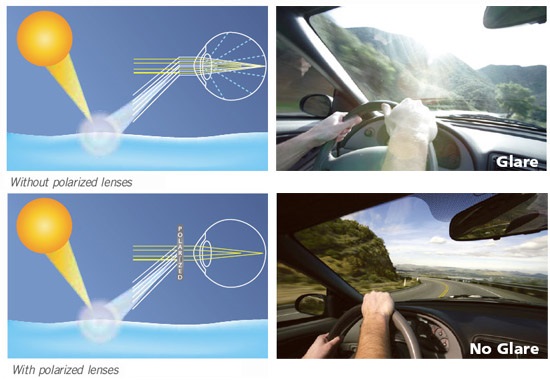
1.) What are the health benefits of wearing polarized vs. non polarized lenses?
There are health benefits of wearing sunglasses, regardless of whether they are polarized or nonpolarized. Sunglasses are meant to filter harmful UV rays and reflected light, making vision more comfortable and improving contrast. In addition, protection from UV rays is important since extended exposure to the sun’s UV rays has been linked to eye conditions such as cataracts, macular degeneration, and certain eye growths (pingueculae and pterygia). Polarized lenses significantly help with glare that is caused by reflected rays off of horizontal surfaces such as snow, sand, water, and some flat roads. Thus, polarized lenses make it even more comfortable to see when boating, skiing, flying, or driving. A standard, non-polarizing sunglass lens only reduces the brightness of reflected glare sources by uniformly reducing the brightnesses of all objects in the field of view by the same amount.

2) Are people’s eyes more sensitive to sunlight depending on their age or eye color?
Yes. As we age, we often develop cataracts, which is a condition when the lens of the eye opacifies and scatters light. If the cataract scatters enough light, it can intensify the the effects of sunlight within the eye, thereby increase one’s sensitivity to sunlight. Eye color also affects our ability to tolerate sunlight. People with light-colored eyes have less pigment in their eyes to absorb light rays and thus effectively have more light entering the eye. Thus people with blue or green eyes tend to be more sensitive to sunlight than their peers with brown or black eyes.
3) Can you “sunburn” your eyes?
Yes. A few hours of exposure to high levels of UV rays can cause damage to the anterior eye, specifically the cornea and conjunctiva. This is called photokeratitis, which is more commonly referred to as “snow blindness”. Symptoms typically appear 6-12 hours after exposure and include eye pain, light sensitivity, tearing, foreign body sensation, or feeling like one cannot open their eyes. These symptoms usually disappear within 48 hours and permanent damage is rare.
 New Bedford Guide Your Guide to New Bedford and South Coast, MA
New Bedford Guide Your Guide to New Bedford and South Coast, MA










Thanks for sharing this information on polarized vs. non polarized sunglasses. I had no idea that polarized lenses could be so useful for people who are doing some sort of outdoor activity. From the picture, it looks like polarized sunglasses would really help with my sun glare problem!